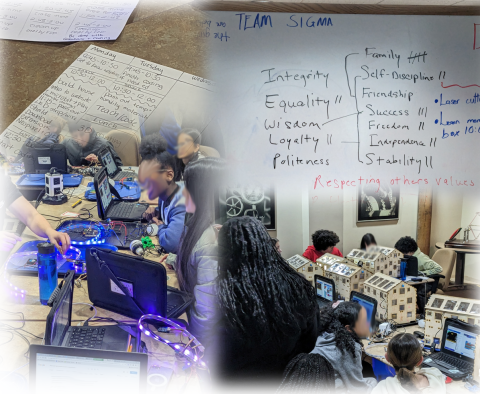Body
Image

Growing STEM leaders through mentoring: Physical Computing and Automated Greenhouses
Central to our work is engaging high school as teachers, mentors, and role models who teach their younger peers in applying concepts and ideas from physics, plant science, engineering design, and coding to design and build a smart automated desktop-sized greenhouse. In the building of the greenhouse, youth use physical computing where they are learning how to connect coding to the physical world through microcontrollers by programing sensors to collect data and using that data to control devices such as fans, lights, and heaters to maintain appropriate environmental conditions for plants in their greenhouse. To program their greenhouse, students use MakeCode, a web-based block programming interface that connects directly to micro:bit, a powerful and low-cost microcontroller. To support the high school youth's interest in obtaining a post-secondary degree, they are mentored by first generation college students from Lasell University's “Pathways to Diversity” program. We focus our recruitment on youth who have been historically excluded from STEM fields and youth who do not have a particular interest in STEM. As such, another key aspect of our work is the longitudinal nature of our research. Our research has focused on student identity and interest development over time as we have been tracking the impact of participation in our programs as youth progress from participant, to teacher, to youth leader.
Pillar 1: Innovative Use of Technologies in Learning and Teaching
Physical computing supports student to become designers, not just users of technology, where they code to collect data and use that data to manipulate the real-world environment. Physical computing covers the design and realization of connecting the digital world to the real world and allows students to develop concrete, tangible artifacts and solutions that require integrated STEM practices where they are blending technological design, scientific investigation, and engineering design.
Pillar 2: Partnerships for Career and Workforce Preparation.
Culturallly sustaining pedagogy is a strengths-based approach that centers on learners and their communities and their diverse ways of knowing by empowering them to learn about their and others’ histories and cultures and drawing upon their own habits of mind and knowledge bases to discern meaning and purpose through their learning and interactions (King et al., 2023). In addition, for many youth, self-esteem and self-efficacy toward STEM are critical if they are to consider studying STEM in the future.
Pillar 3: Strategies for Equity in STEM Education
We use a three-pronged approach to support youth around career and workforce preparation. First youth are engaged in career exploration learning experience using our “Tools for Tomorrow” curriculum (Dr. Maureen Kenny) where youth explore their values, goals, and sense of purpose. Second, youth engage with mentors from Lasell University who are studying education and biotechnology. Third, youth engage in discussions with industry experts from 3D printing companies like Markforged.

Discipline(s)
Computer and informational technology science
Interdisciplinary
Target Gradespan(s)
Middle school (6-8)
High school (9-12)
Target Participant(s)
Youth / students
Project Setting(s)
Informal Education
Category
Developing and Testing Innovations (DTI)